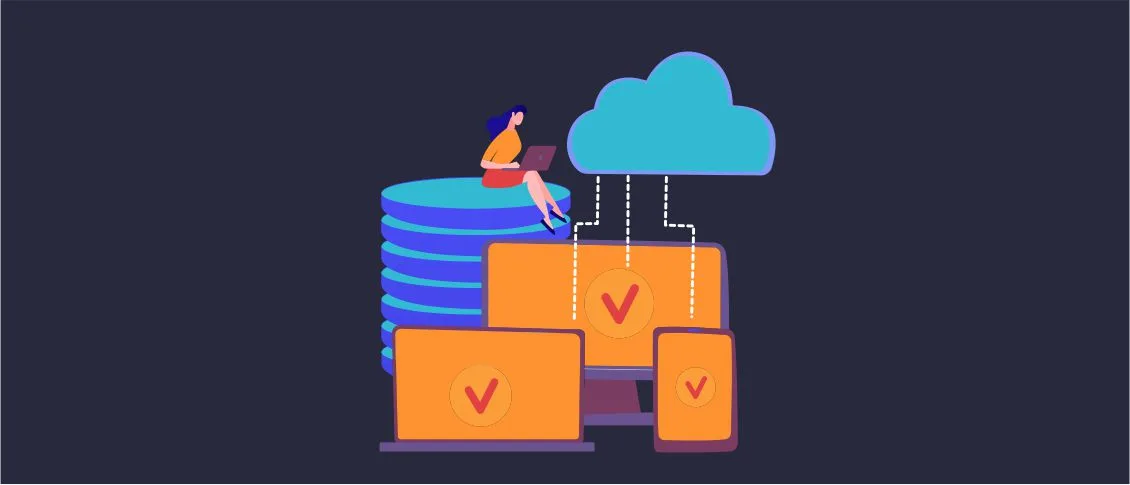- Cloud Migration Explained
- Cloud Migration Types
- Managed Models of Services
- Different Methods for Moving to the Cloud
- Steps to Take While Migrating
- Establish a Plan
- Define a Strategy
- Getting Ready for Migration
- Execute the Migration
- Govern and Manage the Cloud
- Cloud Migration Challenges
- Key Advantages of Cloud Migration
- Cloud Migration Tools and Services
As a game-changing tactic, cloud computing migration enables companies to break free from the limitations of on-premises infrastructure and fully use the cloud migration application potential. This article is a thorough guide that carefully overviews the complexities of cloud migration and describes the several available methods.
Cloud Migration Explained
Transferring your IT assets — including data, applications, and infrastructure — from an on-premises setting to a cloud platform is part of a well-conceived cloud migration process. This may benefit your company by increasing scalability, flexibility, and cost-effectiveness.
Cloud Migration Types
You’ve seen how cloud migration may change a company, now let’s look at the many scenarios you can use to accomplish your IT migration objectives. Every technique has its benefits and meets different demands:
- Datacenter migration. This method physically moves your current data centre infrastructure to the provider’s cloud location. Consider transferring and elevating your complete IT infrastructure onto a more resilient and expandable framework with cloud migration options.
- Hybrid cloud migration. This technique harmonizes on-premises and cloud environments. Imagine it as creating a link between your current setup and the cloud migration project. This way, you may transit to the cloud more slowly or even maintain certain apps on-premises for regulatory reasons.
- Cloud-to-cloud migration. Since cloud computing has become so widespread, many businesses use numerous clouds, often as a result of mergers and acquisitions, and sometimes decide to use cloud-to-cloud migration to transfer resources between their public servers. This kind of business cloud migration is also helpful when a company wants to benefit from the many offerings, services, and costs of cloud platforms.
- Migration of applications, databases, and mainframes. This strategy focuses on the relocation of certain components. Windows Server, Linux, SAP, and SQL Server are a few of the workloads that are moved most often. For better speed and management, you may decide to move certain business-critical apps, crucial databases, or even whole mainframe systems to cloud migration resources.
Examine each of the migration scenarios in great detail to determine which of the available solutions is the most suitable for carrying out the tasks of your organisation.
Managed Models of Services
Cloud service developers provide various managed service models specific to the company’s unique requirements. With these methods, you can concentrate on your primary business operations by outsourcing the labour-intensive task of maintaining your cloud migration remotely. Now let’s examine the three main models:
| IaaS (Infrastructure as a Service) | Cloud providers give on-demand access to networking, storage, and virtual servers. Business cloud migration has total control over these resources, precisely as if you were operating your own physical data centre, but without the need for hardware maintenance and updates. |
| PaaS (Platform as a Service) | This model offers a comprehensive platform that simplifies application creation, deployment, and maintenance. It includes tools, databases, middleware, and operating systems for cloud adoption and migration. |
| SaaS (Software as a Service) | SaaS combines IaaS and PaaS with the additional convenience of cloud app migration, which enables users to connect to and utilise cloud-based software (such as email and office apps) over the Internet. |
Cloud service providers often combine various approaches, so you may design a unique solution that aligns with your IT strategy.
Different Methods for Moving to the Cloud
The best approach for you depends on your current infrastructure, the data and apps you’re transferring, and your business’ general goals. Here are some of the most popular ways to move to the cloud:
- Rehosting. This is a simple method that is often used as a foundation. It’s moving your current data and apps from your physical server to the cloud. Even if it provides a rapid and affordable option for moving routine tasks, it could not completely use the cloud’s potential advantages.
- Replatforming. By using certain cloud features, this strategy benefits rehosting. It’s making cloud application migration and then repurposing them to maximize their scalability and performance in this cloud configuration.
- Repurchase. This strategy entails using cloud-based Software as a Service provider instead of your current applications. In essence, you’re “dropping” your present apps and “shopping” for cloud-delivered new ones.
Remember that combining these methods is often the optimal cloud migration strategy. By carefully assessing your requirements and goals and choosing the best path of action, you can effectively move your IT infrastructure to the cloud and benefit from this game-changing technology.
Steps to Take While Migrating
We’ve examined the different cloud migration tactics, and now let’s discuss the crucial phases of actual cloud migration projects.
Establish a Plan
Developing a plan for your cloud migration is the first step. This first stage establishes the framework for the rest of your cloud migration journey. This is where you have to state your company objectives clearly. Once your goals are clear, choose the kind of cloud infrastructure migration that suits the best your technical requirements and goals. Setting a priority list for which apps to move first is also essential. Consider how important an application is to your company’s operations and how simple it is to migrate it, depending on its complexity.
Define a Strategy
Planning effectively reduces possible problems and guarantees a smooth move. This is where you’ll fully review your current IT setup. Your research should include the programs you use, any cloud migration data links between them, and the current security measures. Lastly, it’s critical to stress the importance of security methods. Creating robust security procedures for sending data is very important. To keep your important data safe in the cloud, you’ll also need to set up ongoing security measures and gated entry channels.
Getting Ready for Migration
In this step, you’ll get your files and apps ready to move to the cloud. Preparing your data for transfer means cleaning and sorting it so it can be moved easily. Data preparation involves cleansing and organizing your information for efficient migration. This minimizes the transfer of unnecessary data, which can slow down the migration process and increase costs associated with data transfer. Rigorous testing and training are also essential during this preparation stage. Application migration to cloud should be thoroughly tested in a staging environment, a replica of your production environment, to identify and address any issues before migrating to the live environment used by your business.
Execute the Migration
This stage involves moving your IT assets, including data and application migration to the cloud. Secure data transfer methods and tools are crucial to ensure your information’s safe and reliable transfer. Once the data is securely transferred, application migration can begin. The chosen big data migration to cloud strategy, whether rehosting applications or refactoring them to exploit the cloud migration capabilities, will dictate the specific approach taken during this phase.
Govern and Manage the Cloud
Cloud migration management involves establishing policies and procedures for ongoing cloud resource management, security, and compliance. This ensures your cloud environment is used efficiently, remains secure, and adheres to relevant regulations. Continuously monitoring cloud performance and resource utilization is also crucial. By identifying areas for optimization, you can ensure you’re getting the most out of your cloud migration project management.
Cloud Migration Challenges
Cloud migration implementation has many advantages, but the process isn’t always easy. Here, we’ll talk about some of the most common problems you might face and how to solve them:
- Security Concerns. Sensitive data cloud migration initiatives can raise security anxieties. Accepting this challenge involves thorough planning and implementing robust security measures. Conduct security assessments to identify vulnerabilities in your on-premises environment and address them before migration. Leverage cloud provider security features and strictly enforce access controls to safeguard your data in the cloud.
- Data Complexity and Migration. Cloud migration in cloud computing can be hard because of how much data and how complicated it is. To get around this problem, you need to prepare your information well. Clean up and order your data to eliminate information you don’t need. Use data-moving tools that can transfer data quickly. Managing complexity can also be easier if you move data in stages, starting with the less important data.
- Integration. It can be tricky to make an app migration to cloud that is still running on-premises. To get around this problem, carefully plan your approach for merging ahead of time. To speed up the process, use cloud-native collaboration tools and APIs. A gradual transfer plan that starts with apps that don’t depend on many others can also make merging easier.
- Training Needs. It’s possible that your team lacks the right skills to handle and use the cloud well. To close this skill gap, you should give your IT team a full cloud migration guide. Many cloud service companies offer training and licensing cloud migration program options that can help your team acquire the skills and information they need to do well in the cloud.
If you are aware of these possible problems and take steps to avoid them, you may migrate your business to the cloud migration platform with greater confidence and with fewer interruptions.
Key Advantages of Cloud Migration
Moving to the cloud is a great option for businesses that want to improve their IT processes and find new opportunities. Here are some of the cloud migration objectives that will happen after you successfully move to the cloud:
- Enhanced Scalability. Cloud technology is naturally flexible, so it can add or remove resources as needed to meet a business’s changing needs. This keeps you from making big, expensive purchases upfront and lets you quickly adjust to changes in the market. Let’s say you need to increase processing power for a yearly sales spike. The cloud makes this easy without having to go through long buying processes.
- Cost Optimization. Cloud mass migration can save you a lot of money. Get rid of the costs of keeping on-premises technology, like the gear, software, and IT staff pay that are used to handling real computers. Pay-as-you-go price is also common in the cloud, which means you only pay for the tools you use.
- Disaster Recovery. Any cloud migration business provides robust disaster recovery options, protecting your apps and data from unplanned interruptions. Suppose a natural catastrophe were to strike your physical data centre. Your company might immediately restart operations with minimum disruption if it has disaster recovery plans and cloud backups.
- Increased Security. Cloud migration deployment companies make significant investments in security procedures to secure your data. Take advantage of frequent security assessments, complete compliance certifications, and cutting-edge security infrastructure. Furthermore, controlling user access and permissions in a cloud environment is often more centralized and efficient.
Moving to the cloud can give your company a lot of benefits, such as increased speed, lower costs, better security, and, in the end, a bigger edge over your competitors.
Cloud Migration Tools and Services
Cloud migration implementation can be hard, but a variety of tools and migration services can make the process easier and ensure the move goes smoothly. There are many useful tools available to you, such as the ones below:
- Cloud Provider Migration Tools. Cloud providers offer tools for assessment, data transfer, and even application cloud migration within their ecosystem. Leveraging these built-in tools can save time and effort, especially for straightforward migrations.
- Third-Party Migration Tools. Cloud transfer tools from outside sources are your best bet if your move is more complicated or you need more features. These tools do more than just move data; they also offer features like thorough task estimates that let you carefully look at your IT environment and choose the best migration method.
- Managed Service Providers. MSPs are experts in cloud migration and offer a comprehensive range of services to guide you through the entire process. They can assist with planning your migration strategy, assess your current IT environment, handle the execution of the migration itself, and even provide ongoing management of your cloud environment post-migration.
Moving to the cloud is much more accessible if you carefully choose the right mix of tools and services based on your needs and budget. Cloud migration and services can provide valuable guidance and expertise, ensuring a smooth and successful transfer.











